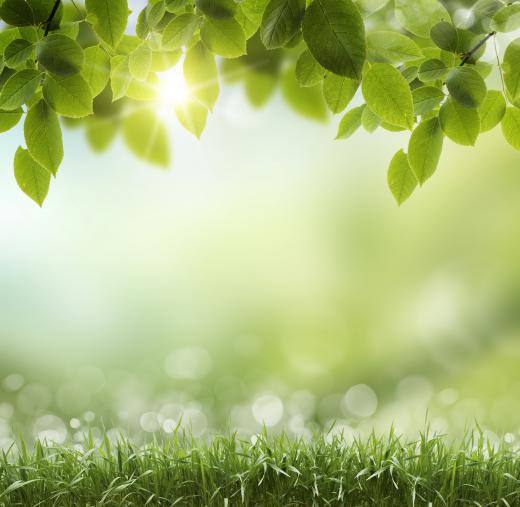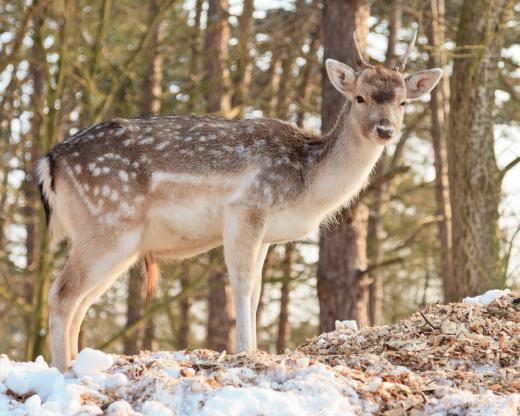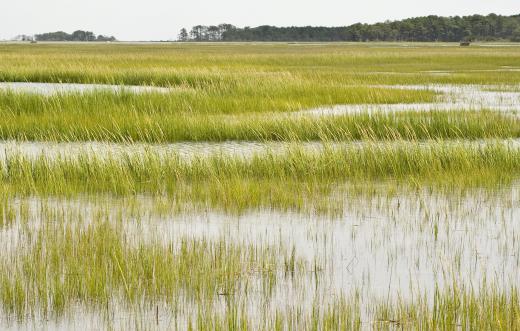What is the Difference Between Flora and Fauna?
The term flora is often used to cover all plants, fungi, and algae in a given environment, while fauna refers to the animals that live there. The scientific definition of flora and fauna is the plants and animals that live in a particular area or time. The difference between them stems from whether plants or animals are being discussed.
In botany, or the study of plants, flora actually has two distinct definitions. First, it can mean the plants of a given environment or period of time, as listed above, or it can refer to a book or such work that describes plants with the aim of identification. This first definition is the most common, and it refers specifically to those plant species that are indigenous to area or time. An indigenous species, whether plant or animal, is one that originated in an area and continues to grow and survive there without any interference by humans. The opposite of indigenous species are introduced ones.

Both flora and fauna have further classifications or subdivisions. Flora classifications depend on the region, climate, environment and period of the plants being described. The fauna subdivisions are based on mostly on where the animals live and their size.
There are many different flora regions across the planet. Some regions can be as large as entire continents or as small as a wetland or mountainous regions. Besides geographic areas, climate and time periods can group different plants into floras. Plants can also be grouped into native, agricultural and garden, and weed flora.

There are seven different subdivisions of fauna that are used, based on where the animals occur and their size. Infauna and epifauna are aquatic animals that live within or on the bottom of the ocean floor, respectively. Microfauna are microscopic in size, while meiofauna are slightly larger and live in both sale and fresh water soil environments. Macrofauna are tiny soil organisms, larger than meiofauna, but smaller than earthworms and nematodes, which are part of the mesofauna group. Megafauna are the large animals of the particular environment being discussed.

Both the flora and fauna of a region are studied separately and together by a number of different types of scientists. Botanists, or plant scientists, mainly study flora, while zoologists study fauna. Ecologists and those studying conservation look at both together, as the two groups are dependent on each other to survive.
AS FEATURED ON:
AS FEATURED ON:















Discussion Comments
What about the different relationships existing between fauna and flora?
If you know anyone who is interested in studying about flora and fauna, there are often unpaid internships available through groups that do things like wetland restoration. With this kind of volunteer work you get to work side by side with botanists and zoologists who are interested in making a difference in keeping our natural world safe. This can be a great opportunity for teenagers who are thinking about studying natural science at a more advanced level.
For those who are passionate about learning more about the wildlife around their area, you can also volunteer to support groups that are trying to preserve the local flora and fauna. Often they have free education programs that work with local government to promote environmental awareness.
If you have children and want to teach the about the difference between flora and fauna, as well as let them learn a bit about their local ecology, it is a great idea to take them to your local conservation area.
Often there are free tours hosted by professionals in the field who can explain the ins and outs of wildlife to your children. They also offer an interactive component that usually entails the children working with an animal or growing their own plant. These kinds of activities can be very exciting for the younger members of your family and is a fun way for them to learn about nature.
@summing - Unfortunately, yes, plants can be endangered too and there is a lot of them. In the same way that animals can be over hunted or have their natural habitats destroyed, plants can be destroyed in mass and have the natural conditions altered so that they no longer support growth. You can find a lot of sites on the internet with list endangered or threaten species. The length of some of these lists will really shock. We pay so much attention to endangered animals, but the consequences of plants going extinct are just as dire.
I'm wondering about endangered flora and fauna. I've heard of endangered animals, but is the same classification given to plants?
It is amazing to me how much variety can exist between local flora and fauna. Sometime the differences can be huge between locations that are just a few miles apart. Think of a place like Colorado that has such a great variety of elevations. It is entirely possible that plants and animals that can live in one place, at one elevation, would die off immediately if moved just a short distance away. Nature is strong but it is also sensitive.
@turquoise - When I hear the word fauna I think of a fawn or a young dear. In a more general way, the word fauna makes me think of some graceful 4 legged creature bounding through the woods. I'm not sure where this image comes from, but It has been an association I've made since I was a little kid. You are right that flora is pretty self explanatory, but I think fauna is pretty evocative too. Whenever you think of fauna, just think of Bambi
Flora reminds a lot of the word flower, right? That's what it actually means! I believe Flora was a Roman Flower goddess and in Latin, it means "relating to the flower." Fauna also comes from Roman mythology, although I'm not sure what it means.
But fauna doesn't really remind us of an English word like Flora does. That can be a really good way to remember which is which. You know that one is plants and the other is animals. So the one that sounds like flowers, flora, is plants and the other, fauna is animals. Really easy!
I think that when we teach kids about flora and fauna in schools, we should also emphasize how important they are for biodiversity. We are losing many of our floras and faunas because we don't protect the environment enough. And when a flora of a region is damaged or destroyed, the fauna which depends on it is endangered as well. Because animals cannot live without plants. They either feed on it directly, feed on something else that depends on it, or use it as their homes.
If we help our kids make this connection between flora and fauna and how together they form the environment at an earlier age, I think the future generations will be more conscious about environmental problems.
I personally try to spend as much time as possible with my kids outdoors and in nature. I want them to get to know about habitats, plants, trees and animals and value them.
Every country has a very unique flora and fauna. I'm really interested in Japan and learned that the flora of Japan is mainly forests of pine, maple and ceder trees. Japan is also known for the cherry trees which have beautiful blossoms in springtime. We have cherry trees in Washington D.C. because Japan sent them to the U.S. as a gift.
Japan also has unique fauna in different parts of the country. In the islands and coastal areas, they have animals like whales, sea lions, coral fish, sea snakes, seals and turtles! They also have tropical animals like lizards and eagles and unique species of deer and ducks that other countries in the same region don't have.
I read that throughout the history, the land that is now Japan split from Asia and joined it again many times. I guess it was because of the movement of tectonic plates. But that is why the fauna is very diverse and unique when compared to the other Asian countries.
I think we can see the results of these tectonic shifts in every country when we study the different flora and fauna it has and by comparing it to neighboring floras and faunas. It can be really interesting to find out where a particular animal originated and came from to a certain place.
Post your comments